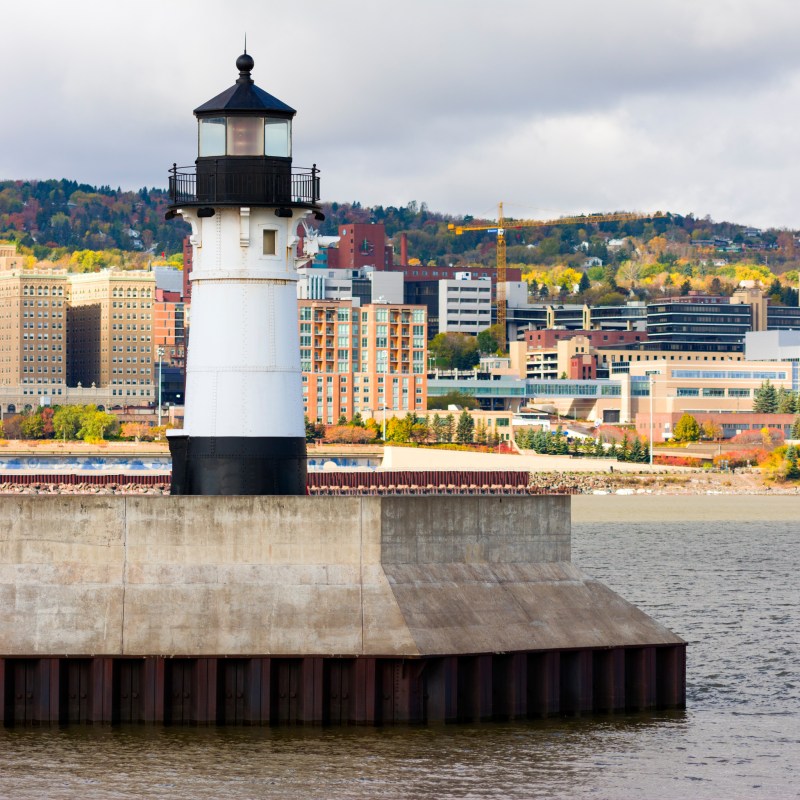
Minnesota’s North Shore Scenic Drive — also known as Highway 61 — is usually a five-hour round trip from Duluth to Grand Portage. However, on my first trip along the 154-mile scenic highway, my wife and I turned it into a 14-hour adventure, exploring several of the 96 possible wayside stops. While you might not be as crazy as us, the attractions will challenge you no matter what. You may find yourself feeling the need to pull over and take in all the scenery along one of the most beautiful road trips in the United States. From deep forests to impressive waterfalls, colorful beaches, and magnificent views of Lake Superior — largest of the Great Lakes — the North Shore Scenic Drive will overload your senses. To help you avoid the craziness that is my wife and I, here is a list of nine amazing places to visit on the North Shore Scenic Drive.
Videos by TravelAwaits
1. Duluth
While it’s easy to spend an entire weekend in Duluth, in order to ensure you enjoy the drive along the highway, start your adventure with a visit to the lakefront. Canal Park is home to the Lakewalk, which takes you along attractions with Lake Superior as a backdrop, such as the Rose Garden and Leif Erikson Park as well as Lake Superior Maritime Museum. Stand near the canal and watch the Aerial Lift Bridge rise as giant ore ships depart for their adventures through the Great Lakes onto their final destinations. For a fun experience, buy some seed or bird-friendly food and feed the gulls that flock near the canal.

2. Two Harbors
North of Duluth, Two Harbors gives you your first sense of what’s in store, with remarkable views of Lake Superior. At times, you’ll swear you’re looking at an ocean. While in Two Harbors, visit Agate Bay Beach near the working docks with ore ships in dock, and see the Edna G. Tugboat, which once worked the Great Lakes and now serves as a museum ship. Take the one-mile walk along the lake north to Burlington Bay Beach, which is more typical of the Lake Superior beaches you’ll find along the scenic drive. Explore the rocky beach and search for agate, which is a popular rock made of quartz and has colorful formations.
Two Harbors is also home to Minnesota’s oldest working lighthouse. Designed as a square tower, the Two Harbors Lighthouse is attached to the lighthouse keeper’s house. Nearby is a small beach and breakwater.
Uptown, Two Harbors has unique shops and attractions, such as the 3M Birthplace Museum. Browse through the rare and odd at North Shore Architectural Antiques, look for locally handmade art and pottery at Silver Creek Company, or check out The Bee’s Knees for Two Harbors souvenirs and gifts.
3. Gooseberry Falls State Park
The drive from Two Harbors to Gooseberry Falls State Park takes you around a cliff. Silver Cliff is the tallest along the scenic drive, and it’s common to see rock climbers ascending it. Park your vehicle on the north side and walk the half-mile paved path that takes you along the original section of Highway 61; you’ll love the panoramic view of Lake Superior. Gooseberry Falls State Park is one of my favorite stops along the North Shore Scenic Drive. The hike along the three falls — Upper, Middle, and Lower — offers majestic views of the river and forest. It’s relaxing to sit back and listen to the roar of the falls. Gooseberry Falls State Park features additional hiking trails as well as historic stone structures built by the Civilian Conservation Corps during the Great Depression.

4. Iona’s Beach And Split Rock Lighthouse
About four miles south of Split Rock Lighthouse, Iona’s Beach Scientific and Natural Area offers a walk along a pink beach. Nor’easter winds chip away at the rock on the surrounding cliffs, causing pieces of pink rhyolite to fall into the lake. Eventually, they wash ashore and give the beach its pink appearance. Iona’s Beach is perfect for a stroll on the rocky beach as well as bird watching.
Possibly the most popular attraction on the North Shore Scenic Drive, nearby Split Rock Lighthouse stands tall on a cliff overlooking Lake Superior, offering beautiful views. It’s recommended to stop at the wayside about a mile south of the lighthouse for a view with Lake Superior as the backdrop. Following your visit, you may want to take a hike along the trail that descends from the top of the cliff to the lake shore. While challenging for some people, the view of the lighthouse and Lake Superior from ground level is memorable.
Pro Tip: Lighthouse tours include a climb to the top, which can be challenging for some people because the staircase narrows near the top. Plan accordingly.
5. Beaver Bay
You can stop at a wayside and watch Beaver Falls, part of Beaver River, which gradually descends 300 feet to Lake Superior. Follow a short trail for a different view of the falls or check it out from the pedestrian bridge alongside the Highway 61 bridge that crosses Beaver River. Beaver Bay is home to eclectic shops, such as Beaver Bay Agate Shop, home to unique art gifts; Shipwrecked Gift Shop, featuring a currency collection from around the world; and Christmas Up North, where it’s the holiday season year-round.

6. Silver Bay
You can get lost in the Silver Bay area and love it! Among the 9,400 acres to explore at Tettegouche State Park are the state’s highest waterfall, six lakes, and more than 23 miles of hiking trails. If you’d like to spend only an hour at the park and enjoy the scenery, the park features four routes that allow spectacular views of Lake Superior. If you want to spend more time at the park and enjoy hiking challenges, Tettegouche State Park is perfect, with three trails (PDF) for you. With uneven terrain, Shovel Point Trail follows a cliffside path from the visitors center, eventually leading to a stunning view of Palisade Head, about 320 feet above Lake Superior. A second trail, High Falls, takes you to the highest waterfalls contained within Minnesota, 70-foot-tall High Falls. You’ll travel to the mouth of Baptism River before beginning a steep climb on a gravel path to High Falls, passing Two Step Falls along the way. A third trail — Tettegouche Camp and Mount Baldy — takes you along steep terrain on a gravel path. Nearby Black Beach, which gets its name from its dark pebbles, features a rocky beach to explore.
7. Lutsen
With its forests, Lake Superior views, and an intimate look at Oberg Lake, the Oberg Mountain Loop is an enjoyable way to experience the nature of the Lutsen area. A short walk to a covered bridge overlooking the Poplar River is an easy walk and offers a wonderful view of the area. The Lutsen Mountains feature Minnesota’s tallest ski area. From spring through fall, you can enjoy a gondola ride to the top to savor the mountain views and explore the area by hiking several trails.
8. Grand Marais
An artist sanctuary, you’ll love exploring this lakeside town’s galleries and shops. From the North House Folk School, where you can learn to create old-world crafts, such as Scandinavian wood bowls, to taking an art class at Grand Marais Art Colony or visiting the Johnson Heritage Post Art Gallery, which features artwork on exhibit, art aficionados will find plenty to do. A stroll through downtown Grand Marais may remind you of a New England village, with quaint shops and local restaurants. With a northern pike sculpture sticking out of the building, you’ll be intrigued by and want to visit Beaver House, a fishing equipment store. Enjoy a walk along the lake and take in the scenery of Artist’s Point in the harbor, too.
9. Grand Portage State Park
Just a few minutes’ drive south of the Canadian border, Grand Portage State Park caps your North Shore scenic drive. Visit the Mount Josephine State Wayside south of the park for an impressive look at the Susie Islands and Isle Royale, part of Isle Royale National Park in Michigan. Following a visit to the information center, which honors the Grand Portage Ojibwe Native Americans, follow a paved path to the Grand Portage waterfalls. As you walk through the woods, follow the thunderous roars of the falls to one of the most immaculate views you’ll ever witness — the 120-foot-tall High Falls. A visit to Grand Portage National Monument traces the fur trade history of the region, which began with the Ojibwe and was eventually managed by the British during their expansion across North America.
